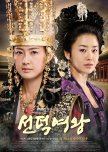The Regnant Queen
Queen Seon Duk is a critically acclaimed epic sageuk production that continues to be held in high regard even to this day, since its release more than a decade ago in 2009. It has taken me just as long to finally watch this remarkable drama as part of my classic watch project, and what a fulfilling journey it has been. All the plaudits rained upon this production have been well deserved indeed, where it has won numerous awards, including honours at the 46th Baeksang Arts Awards.
The Story
The drama is partly a biopic, which cleverly fuses fact and fiction. Set during the turbulent period of the Three Kingdoms, the premise is based on the official records of the Samguk Sagi and Samguk Yusa. However, the storyline is primarily driven by the events chronicled in the controversial Hwarang Segi. The screenplay is infused with much creative liberty, thanks to the writing flair of dynamic duo Kim Young Hyun and Park Sang Yeon, who have written countless epic sageuk including Jewel in the Palace, Tree With Deep Roots, Six Flying Dragons and Arthdal Chronicles.
Queen Seonduk, the first female sovereign of Silla, and her achievements have been celebrated through the ages across all historical texts. On the other hand, historians have argued whether Lady Mishil, her arch enemy, had existed in the first place. Nonetheless, regardless of the historical accuracy, the characters and events are magnificently depicted in this incredible story of love, revenge, betrayal and sacrifice.
The Production
For an MBC drama that was released back in 2009, the general quality of production is worthy of praise indeed. Filmed on location at MBC’s famous outdoor film set, Yongin Daejanggeum Park as well as Shilla Millennium Park, thus reflecting the high levels of authenticity in its set designs. The costumes in the drama, particularly those of the Hwarang, are deserving of acknowledgment.
On the other hand, the cinematography feels quite dated in terms of the camerawork and the typical overuse of close-ups, which is prevalent in older sageuk dramas. You really do get to see actors’ microexpressions up close and personal. The action choreography is not the best, in terms of the swordplay and fight sequences. Interestingly, although this is a sageuk, there are elements of wuxia blended into the choreography. Perhaps this is influenced by Hwarang Segi’s almost fantastical account of the legendary powers of the Hwarangs of Silla.
The Characterisation
This is one of those rare occasions where I actually root for the bad guys instead of the good guys. Although this drama is focused on the character development and accomplishments of Queen Seon Duk, I was won over by Go Hyun Jung’s characterisation of Lady Mishil. She successfully encapsulated this larger-than-life figure who is arguably the epitome of female empowerment, charisma and wit, despite being the ultimate villain. This woman has screen presence and gravitas aplenty, and I honestly feel that she carried the entire show. Other character portrayals that I have enjoyed include Kim Nam Gil’s extraordinary interpretation of the complex and layered anti-hero, Bidam as well as Jung Woong In as the somewhat amusing and rather fun Misaeng.
On the contrary, I feel that Uhm Tae Woong’s depiction of Kim Yoo Shin is a bit flat, where he wears the same lifeless stoic expression throughout the whole show. Meanwhile, Yoo Seung Ho’s Kim Chun Chu is rather one-dimensional. I do think that Park Ye Jin’s Princess Chun Myung is more convincing than Lee Yo Won as Princess Deok Man and later Queen Seon Duk. I know Lee Yo Won has her admirers but I think she was outshone by Go Hyun Jung who went on to win the Daesang at the Baeksang.
Music
The original score, composed by Eom Ki Yeop, is exceptional for a production of this magnitude. Most sageuk soundtracks tend to be inspiring and surreal, which is the case here as well. The main title, comprising upbeat orchestral music, is an absolute favourite. I also love Mi Shil's Theme (미실 테마), an evocative operatic aria. Viewers may not be aware that IU contributed a song to the soundtrack, the lighthearted and catchy To the sea (아라로), which is a fusion of traditional instruments and pop music.
Overall
Queen Seon Duk is actually composed of three major arcs - the first 25 or so episodes before Princess Deok Man enters the Silla palace, the beginning of the palace politics that transpire in the second arc, and the final phase after the key events that take place in episode 50. I personally enjoyed the first arc, which had a measure of action, adventure and excitement. The second arc feels somewhat more regal and solemn in terms of the court machinations. The last 12 episodes probably could have been set aside, since I’m rather torn with the ending especially for one of the characters in question but, suffice to say, all loose ends are neatly tied up.
For fans of epic sageuk, this drama is certainly worth your while to check out. It might be a little old, but this is definitely gold.
The Story
The drama is partly a biopic, which cleverly fuses fact and fiction. Set during the turbulent period of the Three Kingdoms, the premise is based on the official records of the Samguk Sagi and Samguk Yusa. However, the storyline is primarily driven by the events chronicled in the controversial Hwarang Segi. The screenplay is infused with much creative liberty, thanks to the writing flair of dynamic duo Kim Young Hyun and Park Sang Yeon, who have written countless epic sageuk including Jewel in the Palace, Tree With Deep Roots, Six Flying Dragons and Arthdal Chronicles.
Queen Seonduk, the first female sovereign of Silla, and her achievements have been celebrated through the ages across all historical texts. On the other hand, historians have argued whether Lady Mishil, her arch enemy, had existed in the first place. Nonetheless, regardless of the historical accuracy, the characters and events are magnificently depicted in this incredible story of love, revenge, betrayal and sacrifice.
The Production
For an MBC drama that was released back in 2009, the general quality of production is worthy of praise indeed. Filmed on location at MBC’s famous outdoor film set, Yongin Daejanggeum Park as well as Shilla Millennium Park, thus reflecting the high levels of authenticity in its set designs. The costumes in the drama, particularly those of the Hwarang, are deserving of acknowledgment.
On the other hand, the cinematography feels quite dated in terms of the camerawork and the typical overuse of close-ups, which is prevalent in older sageuk dramas. You really do get to see actors’ microexpressions up close and personal. The action choreography is not the best, in terms of the swordplay and fight sequences. Interestingly, although this is a sageuk, there are elements of wuxia blended into the choreography. Perhaps this is influenced by Hwarang Segi’s almost fantastical account of the legendary powers of the Hwarangs of Silla.
The Characterisation
This is one of those rare occasions where I actually root for the bad guys instead of the good guys. Although this drama is focused on the character development and accomplishments of Queen Seon Duk, I was won over by Go Hyun Jung’s characterisation of Lady Mishil. She successfully encapsulated this larger-than-life figure who is arguably the epitome of female empowerment, charisma and wit, despite being the ultimate villain. This woman has screen presence and gravitas aplenty, and I honestly feel that she carried the entire show. Other character portrayals that I have enjoyed include Kim Nam Gil’s extraordinary interpretation of the complex and layered anti-hero, Bidam as well as Jung Woong In as the somewhat amusing and rather fun Misaeng.
On the contrary, I feel that Uhm Tae Woong’s depiction of Kim Yoo Shin is a bit flat, where he wears the same lifeless stoic expression throughout the whole show. Meanwhile, Yoo Seung Ho’s Kim Chun Chu is rather one-dimensional. I do think that Park Ye Jin’s Princess Chun Myung is more convincing than Lee Yo Won as Princess Deok Man and later Queen Seon Duk. I know Lee Yo Won has her admirers but I think she was outshone by Go Hyun Jung who went on to win the Daesang at the Baeksang.
Music
The original score, composed by Eom Ki Yeop, is exceptional for a production of this magnitude. Most sageuk soundtracks tend to be inspiring and surreal, which is the case here as well. The main title, comprising upbeat orchestral music, is an absolute favourite. I also love Mi Shil's Theme (미실 테마), an evocative operatic aria. Viewers may not be aware that IU contributed a song to the soundtrack, the lighthearted and catchy To the sea (아라로), which is a fusion of traditional instruments and pop music.
Overall
Queen Seon Duk is actually composed of three major arcs - the first 25 or so episodes before Princess Deok Man enters the Silla palace, the beginning of the palace politics that transpire in the second arc, and the final phase after the key events that take place in episode 50. I personally enjoyed the first arc, which had a measure of action, adventure and excitement. The second arc feels somewhat more regal and solemn in terms of the court machinations. The last 12 episodes probably could have been set aside, since I’m rather torn with the ending especially for one of the characters in question but, suffice to say, all loose ends are neatly tied up.
For fans of epic sageuk, this drama is certainly worth your while to check out. It might be a little old, but this is definitely gold.
Cet avis était-il utile?


 21
21 35
35 7
7



















